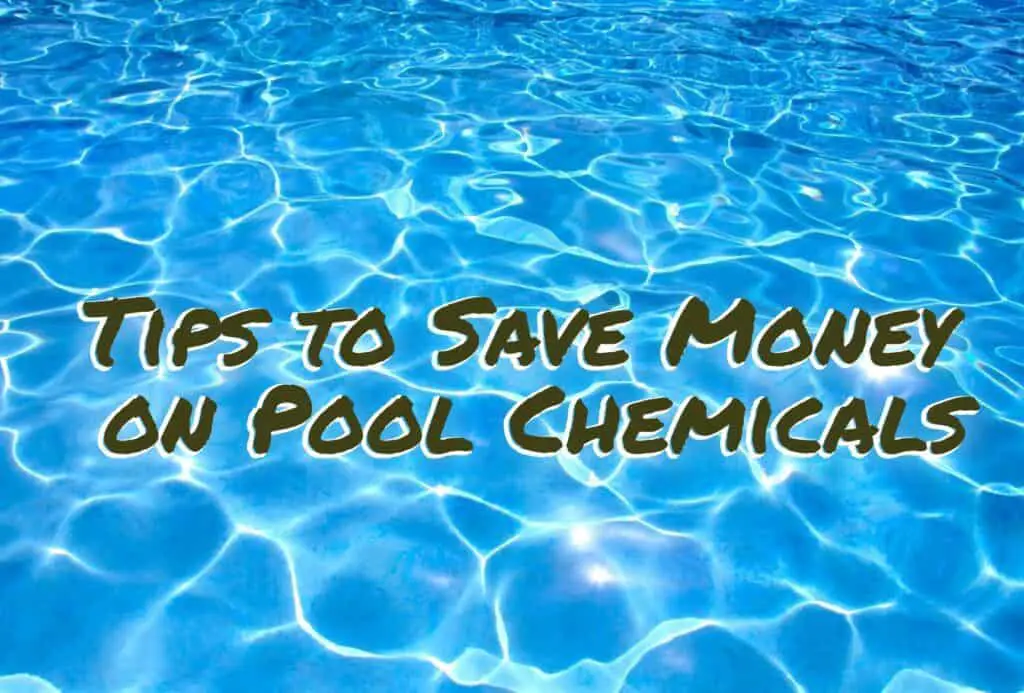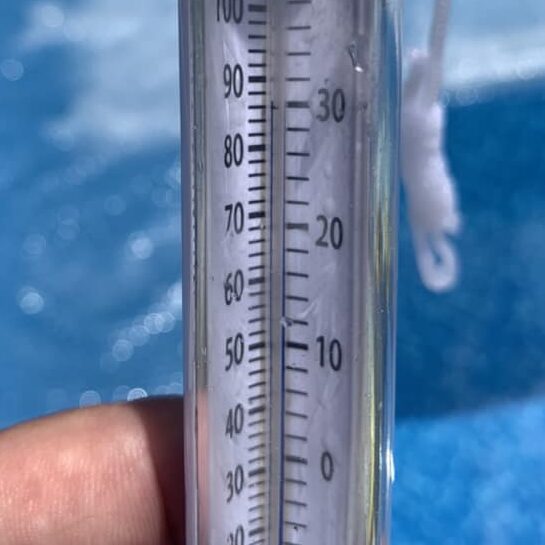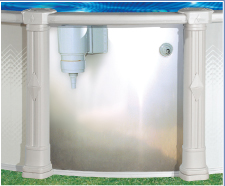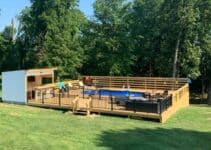Everyone is looking for ways to save money. Owning a pool is expensive but there are a few ways to cut costs on monthly pool chemicals. There are a few different ways to chemically maintain a swimming pool. Some purchase add-ons to help with their pool chemistry. Some follow a routine of using specialty chemicals to help.

Still, some will take a “minimalist” approach and only add chemicals when they think the pool needs it while others adhere to a strict routine and add things regardless of the readings.
AS A GENERAL RULE, THE LESS YOU KNOW, THE MORE YOU WILL SPEND ON POOL CHEMICALS
If you go to a pool store or look at pool chemicals online, you’ll see a thousand different specialty chemical products. A top-level pool maintenance guy wouldn’t use any of them to keep your pool pristine.
Same thing with add-on components that pools have to aid in the chemistry. Things like salt chlorine generators, ozonators, ionizers, and mineral systems do not reduce the cost to chemically balance a pool. While some of these are loved by pool owners, their initial cost will never be recovered by any chemical reduction cost.
So, knowing how to manage the chlorine level in the pool manually (so to speak) is the best and least expensive way to maintain a pool. Knowing this will far outperform any marketing ploy having eye-catching brilliant colors and cool-looking reptile logos.
HOW DO I KNOW THIS?
Well, I’ve been in the swimming pool business for 37 years and counting. And during this time, I had a successful pool maintenance company for sixteen of those years.
A successful business means keeping its overhead as low as possible. With pool maintenance, the biggest cost is in the chemicals it takes to keep hundreds of bodies of water balanced, clear, and healthy.
So, it was my job to experiment with different things to see what it takes to properly maintain a swimming pool for the least possible cost. And experiment I did.
During my sixteen years of owning that maintenance business, I ran all kinds of chemical maintenance experiments and recorded everything for every pool every week. This gave me results that I could match with other experiments and come up with the least expensive ways to keep my pools perfectly balanced.
I also had the opportunity to see how well all the add-on components worked for all shapes, sizes, and depths of pools with all ranges of bather loads and weather conditions.
As my knowledge grew, I started seeing patterns. And these patterns all pointed to the same thing – KISS (keep it simple, stupid).
TRUST MY OPINION YET?
Good. Now you can better absorb my tips on it costing you less to maintain your pool.
17 TIPS TO REDUCE THE MONTHLY CHEMICAL COST FOR YOUR ABOVE GROUND POOL
1. It’s Mostly about Chlorine. Learn to Cycle it
There are a couple of sanitizer and oxidizer alternatives, but make no mistake – Chlorine is the king of pool chemistry. Period.
The most popular alternative to chlorine is hydrogen peroxide. Most know of peroxide and have some in their medicine cabinet. You put it on a fresh cut and it fizzes when it contacts blood. We notice that it doesn’t irritate our skin and other than an initial sting, it’s harmless and cleansing.
At a glancing thought, this sounds like something people would want to use for their pool instead of that corrosive and toxic evil chlorine. Yeah, no.
This article is not all about chlorine so I’ll keep it simple. Chlorine kills things and then gets rid of them better than anything else by far. And that’s really the primary function of swimming pool chemistry.
Adjusting PH, TA (total alkalinity), stabilizer (cyanuric acid), calcium, and TDS (total dissolved solids) are somewhat important, but not much really. I mean, when there is a rare issue, these things will have to be addressed, but under normal conditions, only really the ph should need adjusting.
Cycling the chlorine level means that you can’t just keep the chlorine high all the time. You must let it go down to almost zero on a regular basis. Do this so combined chlorine doesn’t build up in the pool. You don’t want to have a lot of combined chlorine. Only free available chlorine.
Making sure the chlorine level drops regularly will also prevent you from having too much cyanuric acid(stabilizer).
We are all aware that “no means no”. In the pool maintenance world, “shock should mean shock” And shock doesn’t mean shock when the pool has a high level of chlorine in it when you super chlorinate(shock) it.
So, wait until your chlorine level is at least less than 2ppm before shocking the pool with more chlorine.
2. Buy Fresh Liquid Chlorine
Liquid chlorine has a bit of a shelf-life. Quality liquid chlorine will begin with between 10% and 15% chlorine. A month or so later, the chlorine level will reduce to 5% and stabilize to that level.
This means that liquid chlorine sitting on a shelf (like what you get at Walmart or Home Depot) will most likely be 5% chlorine. This doesn’t sound like much, but consider that 10 – 15 percent is two or three times more than 5 percent.
If you can, get your liquid chlorine at a pool store that has a higher volume of business. This will ensure that the liquid chlorine you get is fresh as a busy pool store will get steady shipments of liquid added to their tank.
Fresher liquid chlorine means more chlorine, which can ultimately mean less chemical cost with your pool.
3. Buy Chlorine Tablets in Bulk
Buying tablets at five pounds at a time is more costly than buying fifty pounds at a time. This is bulk buying 101. The drawback is that you need a good place to store a 50lb pail of tabs as they will last you a very long time.
And all chlorine tabs aren’t created equal. Articles on this can make your head spin. I won’t. Keep it simple by getting chlorine tablets that are 99% Calcium hypochlorite. They will be your best value.
4. Calcium is Not Needed for Above Ground Pools
When I install a new above-ground swimming pool, I will always spend ten minutes or more going over the pump, filter, and other add-on components of the pool with the new owner.
If the pool owner has never taken care of a pool before, I often recommend that they take a water sample to a pool store first. The store will analyze the water, tell you what is needed, and then sell it to you.
This is a good start for anyone with a new pool, but there is a drawback that goes with it. And that is that they may sell you some stuff you don’t really need.
What you don’t need for an above-ground pool is calcium.
Without getting into it too far, calcium can (in theory) damage concrete pools because their cement-based surface finish has some calcium in it. So, if a concrete pool’s water doesn’t have enough calcium in it, then it may become aggressive and pull the calcium it’s “Jonesing” from the surface, thus damaging it.
An above-ground pool has a vinyl surface made with no calcium. This means that aggressive pool water (low on calcium) cannot damage the pool or its surface. So you don’t need to add any calcium to the water, ever.
Now you can find anything in opposition here on this wonderful product of an advanced information age called the “internet”. You may find it somewhere stating that aggressive pool water (wanting calcium) CAN harm a vinyl pool OR that it’s needed for the Langelier index OR that you are generally a bad person for not following all the rules. This is only true if you choose to believe it.
Want to save some money on maintaining your above-ground pool? Good. Don’t bother with calcium.
5. It Cost Less to Maintain Regularly
This is the same concept as when you have to heat or air-condition your home. It’s cheaper to maintain a temperature than it is to let it fluctuate.
Let’s say it’s summer and no one is home during the day. You might think that it will use less energy to turn your air conditioner off during the day (when no one is home) and then turn it on later in the day (when you get home). Yeah, no.
The house will get hot during the day (with the AC off) and then it will take a lot of energy (your electric bill) to get it back down to comfortable at night (when turning on later in the day or evening). It will take much less energy “maintaining” the house’s temperature all day by just keeping the A/C on. The same thing goes with heating a house in the winter.
It just takes less energy to maintain a house’s temperature than it does to try to make it the temperature that you want only at certain times. This is the same concept with pool chemistry.
Some people don’t put anything in their pool until it starts looking a little dull or cloudy. This costs them more in chemicals than it would if they just put what was needed to “maintain” it once a week. A lot more, actually.
The reason for this is that with a swimming pool, you are dealing with an environment that things are trying to live and thrive in. The chemicals that you put in the pool are constantly killing what is being born.
Creating a window of growth opportunity for your pool means not only letting a few things live for a while. It means they get to be fruitful and multiply. And multiply they do. Allowing a few algae to stay alive in a swimming pool for a day is the same as allowing a couple of hundred generations (or maybe thousands) to go in full out “breed mode” turning those few into trillions of algae.
The more algae you have to kill and get rid of, the more it costs in chemicals. So, it’s best to kill things before they are allowed to multiply.
The best way to maintain a swimming pool is to do it on the same day every week. This way the pool will never go more than seven days(during the summer months) without replenishing the death chemical levels and keeping it in annihilation mode. Yeah, you guessed it. I’m a guy.
6. The Cost is Not Consistent every Month
Remember this – “The warmer the pool water is, the more things will grow in it”
When trying to figure out what the yearly cost will be to chemically maintain a swimming pool, it’s good to know that most of the cost will occur during the summer as that is when the water is at its warmest.
What does this have to do with reducing chemical cost (which is the reason for this article)? Well, some will continue to add what they have been adding to their pool over the summer well into the fall months. And that is a waste of money.
This isn’t an issue for those who know how chlorine really works and cycle it (See #1) as the chlorine demand will go down when the water gets cooler (entering fall), so they won’t add as much as often.
Think of the story of “Goldilocks and the Three Bears”. You want your chlorine levels to be “just right”. Too much is not good in the long run and not enough is not good right away.
Be aware that the chemical demand for your pool will be different with every season and you will save by not overdoing it during the transitions going in and out of the hot months.
7. The More Gallons, the More Cost
This is mainly for those considering a swimming pool and what size they should get. This is so simple but often overlooked. The bigger the pool (more gallons of water), the more it will cost in chemicals and maintenance time.
Bigger is not always better. If you want to save on what it costs in time and money for a swimming pool, then don’t just get the biggest thing that fits in your yard. Get the right-sized pool for your needs instead, which is often smaller than you are thinking.
8. The More Debris, the More Cost
Anything that falls into a swimming pool will add to the cost to maintain it both in chemicals and clean time. Dust, leaves, rainwater, bugs, swimmers, dogs, floats, etc. will all cause the pool to need more chemicals.
If your pool is under a canopy of trees, then that means stuff is constantly raining down and hitting the pool surface, then some of it gets saturated and sinks to the bottom. It will use a lot more chemicals than a pool that is in an open area with no trees around it.
The same thing goes with bather load. A pool with a lot of swimmers will use more chemicals than one with little or no swimmers.
Pools that get a lot of rain and windy conditions will need more chemicals than one not getting much rain.
If you want to save on chemical costs, then know that reducing what is entering the pool will save you. Cutting some trees back, skimming debris out of the water before it sinks, covering the pool periodically, and disallowing dogs or any unwanted swimmers from using the pool are some things that can reduce the chemical cost.
During my pool service business years, I had a pool on my route where the owner had five large dogs. That pool was very hard to maintain and every week I had to put a ton of chlorine in it. I found out after a while that the lady was washing her five dogs in the pool every week. This was costing me more in chemicals to maintain her pool.
A pool that is kept clean means that less debris is hanging out in the pool. This will result in less overall chemical cost.
9.The More Swimmers, the More Cost
Bather load is an important factor when determining the cost of maintaining a swimming pool. This is a big reason why service companies have to charge 2 – 4 times more to maintain commercial pools of the same size.
If there is a fluctuation in the number of swimmers in your pool, then just know that the chemical cost will fluctuate with that.
I’m not suggesting that you try to save money by not letting anyone swim in your pool. I mean, a pool is a social structure made for multiple human usage. Just be aware that the more people in the pool, the more it will cost.
10. Yellow Algae are Unavoidable
As a pool guy with a high level of pool chemistry knowledge, I can successfully avoid a swimming pool from turning green for years. When it comes to yellow-colored algae though, I or anyone else may not be able to.
New swimming pools may not get mustard/yellow algae in the beginning months or even during the first year or two (depending on where you live). Eventually though, most pools will start to get yellow algae blooms on a regular basis.
My first piece of advice here is to not beat yourself up about it. We all get mustard from time to time. The second piece of advice is to learn about it and how to get rid of it well.
Knowing the characteristics of yellow algae and how to maintain and get rid of it will save you potentially a lot.
11. Keeping Clean Reduces Cost
This is an extension to tip #8. Keeping a swimming pool clean means debris isn’t allowed to hang out in the water for very long. And that reduces chemical costs.
Also, piles of leaves and stuff left on the pool bottom allow for algae to grow under it as the chlorinated water cannot get in there and keep it from multiplying. Skim, vacuum, and brush regularly.
12. Algaecides, Clarifiers, etc. Increase the Cost
Specialty chemicals are expensive alternatives for maintaining a swimming pool. Period.
Now I’m not one to argue with success. If you are buying some algaecide or nature something or something with a cute reptile on it and the pool looks great, then awesome. Keep up the good work.
If you want to save on pool chemicals though, this can be the best avenue of savings for some. Pools guys that know their stuff who you pay to maintain your pool won’t use anything special. There is no magic secret product that the people “in the know” are using and not telling you about.
In reality, it’s the opposite. The cooler the colors, the bigger the display, the happier looking the mascot or logo for the product, the less likely it works. And nothing does what it claims.
My neighbor is a great example of this. He has a large pool and thought he needed all this specialty garbage to keep his pool clear. His thinking was that he needed expensive chemicals because his pool was so big and fancy. Yeah, no.
We weren’t friends for many years. Just neighbors. Then we became great friends. While becoming friends, he was telling me that his pool always looks great, but it costs him a lot. “How much”, I asked.
“About two hundred bucks a month in the summer,” he said. In a non-judgmental way, I expressed to him that he may not have to spend that much. Another year went by before I was able to show him that he didn’t need to buy all the fancy stuff that he was getting for his pool.
In short, he now spends about thirty dollars a month to maintain his pool in the summer. And it looks better than it did before.
This is an extreme example, but not uncommon. Learning how to cycle your chlorine levels properly and maybe adjusting the PH when it needs it is all you need. The hardest part may be in your believing that.
Now, don’t get me wrong. Things can get out of whack in swimming pools for one reason or another. And when that happens, it might take some knowledge tweaking to get it back in shape. This is rare though for pools maintained simply and without specialty products.
13. If the Pool Leaks, it will Cost More
Swimming pools that leak cost considerably more in chemicals to maintain. This is because new water has to be regularly be added. And this new added water can either have no chlorine in it and/or have metals and algae, or it can be municipal water that has a lot of combined chlorine or yellow algae in it.
You shouldn’t let an above-ground pool leak for too long anyway as that can cause it to rust out prematurely and die at an early age.
It can be a real pain to find a leak in any pool, especially an above-ground type. Do what it takes to get the thing to stop leaking though. It will save you in chemical cost whether you think so or not.
14. If Poor Equipment, it Will Cost More
The much less expensive soft-sided type(Intex, Coleman, Bestway) pools don’t cost much, but come with horrible equipment.
Poor, undersized, and/or cheaply made pool equipment(pump/filter) don’t filter or circulate the pool’s water very well. Water that doesn’t move much doesn’t get much oxygen which promotes algae growth.
And pool water needs to have unwanted micro-debris filtered out of it. If not, then more combined chlorine can occur and there is a greater environment for algae growth.
A good properly sized pump and filter that is not working well are just as bad. You want your pump to move the water well and the filter to clean the water well. Limping along with equipment in poor condition will most certainly cost you more in chemicals for the pool each month.
Make sure your pump isn’t partially clogged and is pumping the volume it’s supposed to. And make sure the filter is catching the micro-debris it’s designed to. If not fix or replace it. It’ll save you some chemical costs.
15. If Poor Circulation, it Will Cost More
Above-ground pools can be prone to having circulation issues. Dead spots and/or slow-moving water can cause algae issues. And algae issues cost you more in chemicals.
Learn more about circulation here and make sure your above ground is circulating well.
16. Add a Main Drain
In the 35 years of my being in the above-ground pool business, I have installed my share of main drains. I always feel good about installing each one as I know the benefits for the pool and pool owner.
The most gratifying main drain installations for me though are the ones I put in existing pools (during a liner change-out). These are usually for people who had issues maintaining their pool. Adding a main drain will make it so much easier for them. And it will save them in chemicals too.
Learn about main drains and above-ground pools here.
17. Add an Extra Return
I’m a bigger fan of the main drain, but for some, the answer for their above-ground pool is to add an extra return fitting.
Above-ground swimming pools only come with one place for the filtered water to return back to the pool. And that return is right next to where the unfiltered water enters the equipment (at the skimmer).
Adding an extra return line can help with circulation which can save you in chemical cost every month.



Great site! Love the information you provide. I use the BBB method for maintaining my chemicals. Can you add your knowledge about that? Thanks!
Help!!
My Father in Law bought a new house & it had a summer waves elite pool already put up! However the pool cover was basically none existing, the water was gross looking & who knows what was in it! Well My Sister in Law & Father in Law attempted getting it up & running however they hooked the pump up backwards or something causing all the filter sand to go in the pool, however they did manage to get the nasty green pool water to super cloudy and not healthy looking at all after filling the pool the rest of the way up with the hose & adding chemicals & vacuuming it! They are a week in and nothings getting better! The previous owners said the pool was up & running last year but I dont know if thats true, honestly it looks like the previous owner bought the pool, picked a spot & just put it together & over time maybe sunk into the ground some because the top in spots is leaning in & the dirt and grass build up around the outside bottom of the pool!! ♀️
Any Suggestions or Tips Please!?!?